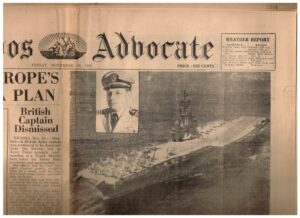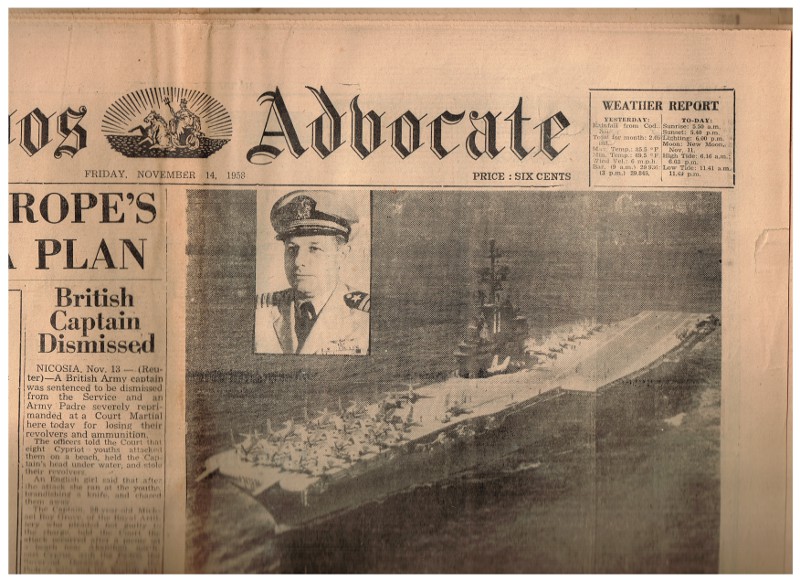
Friday, November 14, 1958 Barbados Advocate
Article on front page with Photo of Intrepid with Inset of Capt. Paul Masterton, Commander
American Aircraft Carrier Arrives at Barbados

The 893 feet of formidable striking power that is the aircraft carrier U.S.S. Intrepid dropped anchor in Carlisle Bay shortly before 10 A.M. Yesterday carrying aboard Vice Admiral Bernard L. Austin, Commander of the Second Fleet and the Atlantic Striking Fleet, and commanded by Capt. Paul Masterton.
At 10:40 a.m. The Vice Admiral came ashore accompanied by his Aide, Capt, Daniel Smith and inspected a Guard of Honour of Police. He then went to Government House for a courtesy call. The call was returned by His Excellency the Governor Sir Robert Arundell, who boarded the vessel shortly after noon.
Later in the day the Vice Admiral met members of the Press and Radio on board the Intrepid which is his Flagship.
The Intrepid which will remain here until Monday morning has a complement of 300 officers and 2,800 men. It carriers more than 50 planes of various types.
The Vice-Admiral was met at the steps of the Baggage Warehouse by Lieut. R. Brander A.D.C. To His Excellency the governor, Major Ronald Stoute Commissioner of Police and Major A.J. Parsons, Adjutant of the Barbados Regiment.
Guard of Honour
The Guard of Honour which was composed of one officer and 50 other ranks was drawn up under the command of Capt. W.H.R. Armstrong, Acting Commandant of the Police Training School. The men were all from the School, and the vice-Admiral told the Press later that he was impressed by the “ship shape” outfit, and was surprised to learn they had been in training for only six months. The Police Band under Capt. Raison provided the music for inspection of the Guard.
Vice-Admiral Austin who assumed command of the Second Fleet and Striking Fleet Atlantic in May 5, 1958, holds among other decorations the Navy Cross with Gold Star in lieu of a second Navy Cross. He is married, and his official residence is at Rock Hill, South Carolina.
Capt. Smith has been with the Second Fleet from September, 1957. He became Chief of Staff and Aide to the Commander in August this year. He is married and has two children. He is currently making his home in Virginia Beach, Virginia.
Capt. Masterton has seen over 24 years in the U.S. Navy. He was twice presented with the Distinguished Flying Cross and was awarded the Air Medal six times.
Executive Officer of the ship is Commander Paul M. Paul.
Crowds yesterday lined the wharf to see the Intrepid steam into port. Shops and stores got ready for the visit of the servicemen and the City’s places of entertainment were already “on the beam” to provide a traditional sailors’ welcome.
The USS Intrepid was commissioned August 16, 1943 at Norfolk, Virginia. On December 3, 1943 she joined the Central Pacific Services. She saw extensive action during World War II being torpedoed and hit by kamikaze planes. She was the first U.S. Carrier to be equipped with Sparrow air to air guided missiles. She was converted to an angled-decked carrier last year.
First Visit
Vice-Admiral Austin said during the Press Conference yesterday that this was his first visit to Barbados, although he had visited some of the islands in the area . Capt. Smith had been in Barbados before.
The vice-Admiral said that the ships which normally composed the Second Fleet were not stationed anywhere; but their home ports were at Newport, Norfolk Mayport and Boston.
As Commander of Striking Fleet, Atlantic, he had a NATO responsibility, Admiral Austin said. Training was carried out in this area as well as in northern waters. They had one ship at the Naval Base in Trinidad – the Flagship of the newly formed force that operated in the South Atlantic.
Asked about the Relationship between the U.S. Navy and the British Navy as far as their responsibility to NATO is concerned, the Admiral said they were not trying to take each others places. Their idea was to help each other in doing the job and it was a job that was big enough for both of them.
The British and Americans were working harmoniously together, said Admiral Austin, and shared the burden together with their other NATO allies.
Fastest Planes
In reply to a question about the Sparrow air to air missile, Admiral Austin siad that most of the planes on the Intrepid could be fitted to fire such missiles. Fastest of the planes on board, he added, were the Jets of the F-4D Class.
Most of the crew – about 80 percent – were doing National Service which meant they might or might not, after their training period decide to make the Nay a career. Unlike the British system, he explained, there were several varieties if National Service.
Speaking about the ship itself, the Admiral said it was not the most modern, but had been modernized in 1957. It had among other things, an angle deck and steam catapults and practically all the capabilities of the more modern carriers.
Queried as to whether the ship could be converted so that it could be atom-powered admiral Austin said that while it was possible, it would be more costly that to build a new ship. Experts had discovered that. He did not believe, he added, that with the advent of the missile age the Navy would require less personnel.
Missile Exercised
His Fleet normally did missile exercises as part of the training programme, but none had been done on this occasion. Missiles were expensive things, he declared, and the number which they were allowed for a year did not admit of their firing them every time they went to sea. They were also equipped to do missile tracking work although that was not their primary mission.
Admiral Austin was then asked if now that the West Indies had became a Federation, the U.S. Would be willing to help train West Indians if the Federation decided to form its own Navy.
That, he replied, would be a question for consideration between government and government, but he was of the opinion that it might be arranged through the Mutual Air Programme.
Discussing the benefit of the visit of the ship from the point of view of cash coming into the island, the Admiral said that about tow-thirds of the crew of toughly 3,000 would be able to go ashore. If each man spent an average of $5.00 it would mean that ten thousand dollars would be spent here.